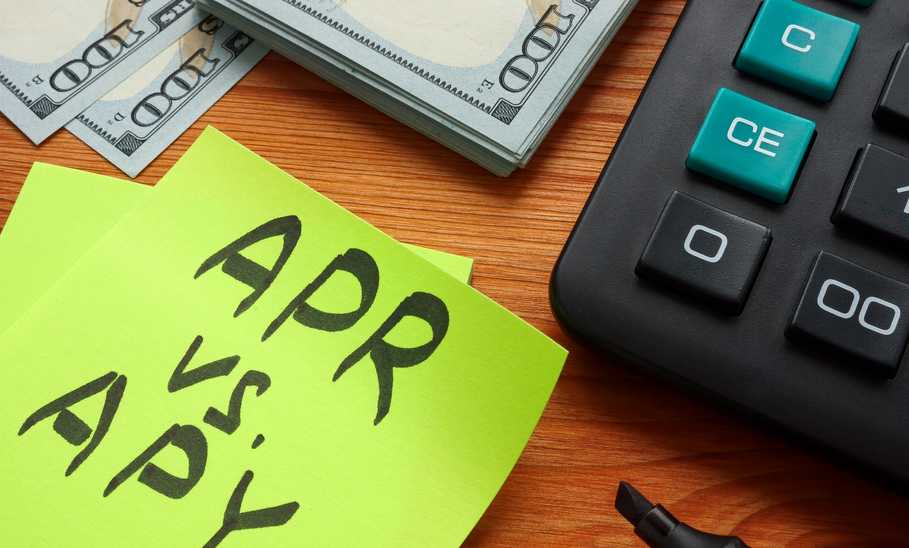APR vs. APY: Are They the Same?


Our evaluations and opinions are not influenced by our advertising relationships, but we may earn a commission from our partners’ links. This content is created by TIME Stamped, under TIME’s direction and produced in accordance with TIME’s editorial guidelines and overseen by TIME’s editorial staff. Learn more about it.
While annual percentage rate (APR) and annual percentage yield (APY) might sound similar, their meanings are very different. One refers to how much it will cost to borrow money, while the other covers how much you’ll earn from saving money. Understanding them can help you better manage your finances.
| Factor | APR | APY |
|---|---|---|
Purpose | Annual cost of borrowing money | Amount of money earned when saving money |
Interest calculation | Simple interest | Compound interest |
Fees included | Yes | No |
Numerical rate | Lower is better | Higher is better |
APR is the annual cost of borrowing money. It is usually associated with credit cards, auto and home loans, personal loans, and more.
APR includes the interest you’ll pay for borrowing money and any fees associated with the loan. For example, if you take out a home loan, you may pay for things such as mortgage points, loan origination fees, and other lender fees. These fees and the interest rate all make up the APR.
When you apply for a credit card, the interest rate and APR are usually identical. This is because credit cards generally don’t have additional fees, unlike other types of loans.
Understanding how APR works is easiest when thinking about credit cards. The APR on a credit card is usually just the interest charged when you carry a balance. For example, let’s assume you made a purchase on your card for $1,000. If your APR on the card is 18%, you’ll pay $180 in interest over a year.
When fees are part of an APR, it gets more complicated. For example, with a mortgage, some fees, such as origination fees, are included in the closing costs and paid up front—while others, such as mortgage insurance, are paid monthly. The APR gives an accurate representation of the total cost of borrowing, but it doesn’t measure the impact of when you pay what. Also, sometimes, every fee is not included in the APR calculations. Should that happen, it’s important to know what they are and plan for them separately.
Most credit cards compound interest daily, but this isn’t typically factored into the APR. This means you could pay more or less depending on your monthly payments. For example, if you made a $250 payment toward your $1,000 balance, the next month, you’d pay interest on the $750 balance plus the interest accrued the first month.
The amount you actually pay when taking compounding into account is called the effective interest rate (EIR) or effective annual interest rate (EAIR). The formula for EIR is:
Where
For example, suppose the APR on your credit card or loan is 16% compounded daily. The calculation would be as follows:
The best way to avoid paying interest is to pay your card balance in full at the end of each billing cycle. Below is a table that shows the actual APR, i.e., EIR, you might pay when factoring in compounding on a quarterly, monthly, and daily basis.
| APR | EIR w/quarterly compounding | EIR w/monthly compounding | EIR w/daily compounding |
|---|---|---|---|
16% | 16.985% | 17.227% | 17.347% |
18% | 19.251% | 19.561% | 19.716% |
20% | 21.550% | 21.939% | 22.133% |
APRs can vary widely. As of June 2024, a good APR rate would be anywhere from 16% to 20%. However, the best APR you can receive is 0%. While most lenders don’t offer loans this low because they wouldn’t make money, credit cards often offer introductory 0% interest on purchases and/or balance transfers. This is typically for anywhere from six to 24 months.
The Federal Reserve publishes a monthly report documenting the average APR for different products. The July 8, 2024, report has figures as of May 2024. It puts the average credit card APR at 21.51%. Personal loans with a 24-month term come in at an average of 11.92%. New car loans for 60 months are at 8.20%.
APY is sometimes called the “earned annual rate (EAR).” This is the interest you’ll earn on savings or deposit accounts. The higher the APY, the more interest you’ll earn.
Unlike APR, which uses a simple interest method, APY is calculated using compound interest, which is the amount you’ll make on your initial deposit plus any interest you’ve already earned. Interest can compound daily, monthly, quarterly, or yearly. The more frequently it compounds, the faster your savings will grow.
To give you an example of how compound interest works, let’s assume you deposit $1,000 in a savings account, and it earns $4 in interest during the first month. For the second month, interest will be calculated based on $1,004 ($1,000 + $4).
Even though most banks will promote specific interest rates on products, the actual APY you can earn will depend on how the interest is compounded.
Below is the formula to help you understand how to calculate APY.
Where:
When the “days in term” is 365 (that is, where the stated maturity is 365 days or where the account does not have a stated maturity), the annual percentage yield can be calculated by use of the following simple formula:
Below is the formula to help you understand how to calculate the compounded APY.
Where:
| APY quote | Compound |
|---|---|
2.00% | 2.02% |
4.00% | 4.07% |
6.00% | 6.17% |
What makes for a good APY is somewhat subjective. However, the higher the APY, the better it’s considered. According to the Federal Deposit Insurance Corporation (FDIC), as of July 15, 2024, the average interest rate on a savings account was 0.36%, and the average CD rate ranged anywhere from 0.25% to 1.98%, depending on the CD term. (These rates don’t include savings accounts at credit unions, which are not insured by the FDIC.) Don’t be stopped by averages, though: You can find higher interest rates on many savings and CD accounts.
If you’re looking for the best APY or APR, compare several different banks or lenders to see how they stack up against each other. It’s important to compare like products: savings account to savings account or mortgage lender to mortgage lender. This will provide you with the best rates available.
While APR and APY sound similar, you can now see how different they are. Whether you are looking for a new savings account or home loan, understanding how each works and is calculated can help you make a more informed decision when picking a product.
Neither is better; they are different things. And you don’t accept them; they come with the territory. If you want to borrow money, you want a low APR. If you want to save money, you want a high APY.
Especially when it comes to mortgages, an APR doesn’t always reflect all the associated fees, so it may underestimate the total cost of the loan. In addition, mortgages usually have a long term for repayment, such as 30 years. Amortizing the fees over that period can underestimate their impact if you end up paying off the mortgage in a shorter time frame.
No. An APR comes with any loan. However, in the case of mortgages, making at least a 20% down payment will usually lead to a lower interest rate and being able to avoid mortgage insurance, which should reduce your APR.
The information presented here is created by TIME Stamped and overseen by TIME editorial staff. To learn more, see our About Us page.



